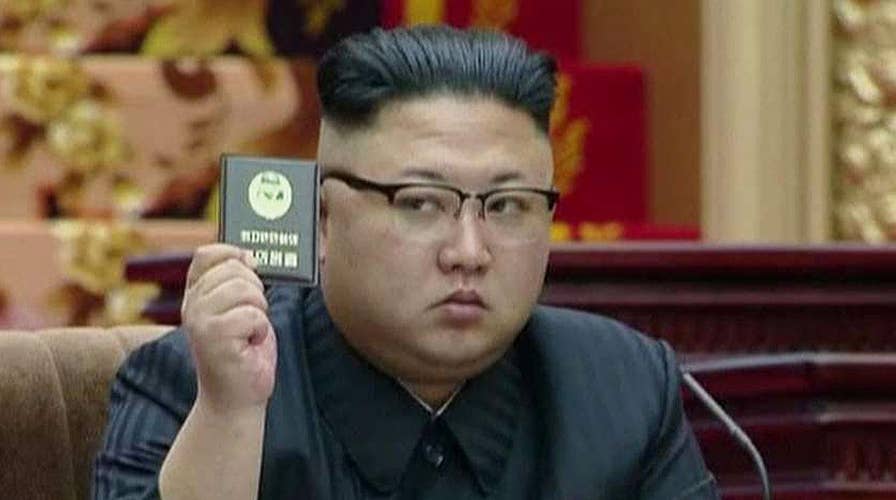US bracing for possible nuclear test by North Korea
Military tensions escalating to dangerous levels; 'The O'Reilly Factor' investigates
North Korea paraded its intercontinental ballistic missiles on Saturday in a massive military display in central Pyongyang amid rising tensions across the region.
Kim Jong-Un did not speak during the parade, the annual highlight of North Korea's most important holiday, which celebrates the 1912 birthday of his grandfather, Kim Il Sung, the country’s founding ruler.
One of Kim’s top officials warned that North Korea would stand up to any threat posed by the United States. Choe Ryong Hae said President Donald Trump was guilty of "creating a war situation" on the Korean Peninsula by dispatching U.S. forces to the region. Outside analysts consider Choe to be North Korea's number two official.
"We will respond to an all-out war with an all-out war and a nuclear war with our style of a nuclear attack," Choe said.
The parade came amid growing international worries that North Korea may be preparing for its sixth nuclear test or a major missile launch, such as its first flight test of an ICBM capable of reaching U.S. shores.
But if the parade signaled a readiness for war, North Korea has long insisted that its goal is peace — and its own survival — with its growing arsenal a way to ensure that the government in Pyongyang is not easily overthrown.
North Korea saw the toppling of Saddam Hussein in Iraq and Moammar Gadhafi in Libya — neither of whom had nuclear weapons — as proof of the weapons' power.
"It will be the largest of miscalculations if the United States treats us like Iraq and Libya, which are living out miserable fates as victims of aggression, and Syria, which didn't respond immediately even after it was attacked," said a Friday statement by the general staff of the North Korean army, according to the official Korean Central News Agency.
U.S. retaliatory strikes against Syria over a chemical weapons attack on civilians, coupled with Trump dispatching what he called an "armada" of ships to the region in a show of force, touched off fears in South Korea that the United States was preparing for military action against the North.
Pyongyang has also expressed anger over the ongoing annual spring military exercises the U.S. holds with South Korea, which it considers a rehearsal for invasion.
U.S. officials said on Friday that Trump’s advisers weighed a range of ideas for how to get North Korea to abandon its nuclear program. U.S. officials told The Associated Press that the administration had settled on a policy that will emphasize increasing pressure on Pyongyang with the help of China, North Korea's only major ally, instead of military options or trying to overthrow Kim's regime.
A U.S. military official, who spoke on anonymity, said the U.S. doesn't intend to use military force against North Korea in response to either a nuclear test or a missile launch.
Kim was greeted Saturday with thunderous applause as he stepped into view on a large podium, clapping to acknowledge the thousands of soldiers and civilians taking part in the parade at Kim Il Sung Square.
A series of what appeared to be KN-08 missiles were among the weaponry rolled out on trucks. Military analysts say the missiles could one day be capable of hitting targets as far as the continental United States, although North Korea has yet to flight test them.
The parade also included large rockets covered by canisters in two different types of transporter erector launcher trucks, or TELs.
Other military hardware at the parade included tanks, multiple rocket launchers and artillery, as well as a solid-fuel missile designed to be fired from submarines. Also on display was a powerful midrange missile that outside analysts call a "Musudan," and which can potentially reach U.S. air bases in Guam, as well as a new solid-fuel midrange missile that can be fired from land mobile launchers, making them harder to detect before launch.
Kim emphasizes nuclear weapons as the foundation of his national defense strategy. During his New Year's address, Kim said the country’s preparations for an ICBM launch had "reached the final stage."
Satellite imagery suggests North Korea could conduct another underground nuclear test at any time. The country conducted two nuclear tests last year. North Korea also launched a long-range rocket last year that put a satellite into orbit, which Washington, Seoul and others saw as a banned test of missile technology.
The Associated Press contributed to this report.
